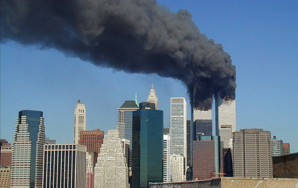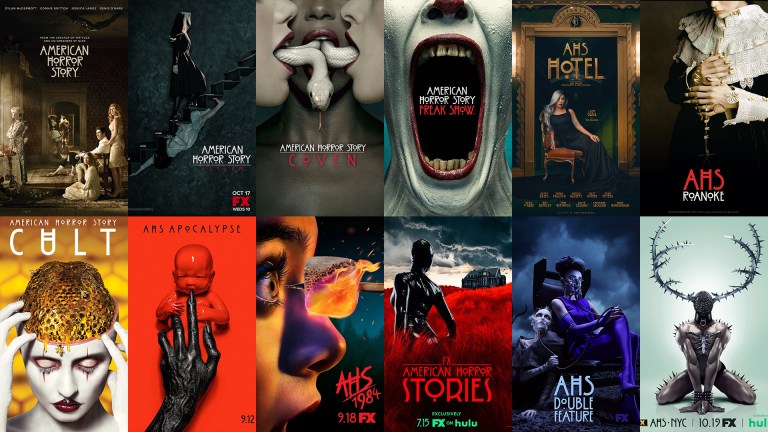The Savage Eye: Aesthetics After 9/11
We’d seen this movie before; suddenly, we were living it, even as we were seeing it through the aestheticizing lens of media memories.
By Mark Dery


The reflexive habit — reflexive, at least, in these United States — of falling back on the mythic languages of Hollywood and Madison Avenue when we’re narrating our lives is a fact of life in the Society of the Spectacle. In his essay “This is Not a Movie,” the New Yorker critic Anthony Lane noted TV commentators’ tendency, on 9/11, to resort “to a phrase book culled from cinema: ‘It was like a movie.’ ‘It was like Independence Day. ‘It was like Die Hard.’ ‘No, Die Hard 2.’ ‘Armageddon.’”

Apparently, even the severe-clear horrors of 9/11 weren’t immune to the Stepfordization all around us — the replacement of the immediate by the mediated, the physical thing by its filmic image. Reversing the polarities of the real and the fake gives Americans a big, fat, Baudrillardian migraine because, while European philosophers seem to think of the United States as Disneyland with the death penalty, we pay lip service, at least, to the primacy of hard fact and harbor a romantic attachment to authenticity. (Umberto Eco maintains that our longstanding love affair with the simulacrum — Disneyland, Forest Lawn, Las Vegas — is borne, paradoxically, of the fact that “the American imagination demands the real thing and, to attain it, must fabricate the absolute fake.”
Yet the ontological vertigo caused by the destabilization of the Real is nothing compared to the moral nausea we feel when filmic images insinuate themselves between us and our visceral reactions to real-life horrors, refracting other peoples’ agonies — and, sometimes, our own — through an aesthetic prism. Lane freeze-frames that moment:
What happened on the morning of September 11th was that imaginations that had been schooled in the comedy of apocalypse were forced to reconsider the same evidence as tragic. It was hard to make the switch; the fireball of impact was so precisely as it should be, and the breaking waves of dust that barreled down the avenues were so absurdly recognizable… that only those close enough to breathe the foulness into their lungs could truly measure the darkening day for what it was.
We’d seen this movie before; suddenly, we were living it, even as we were seeing it through the aestheticizing lens of media memories.

“Dust and ash coated all,” write the editors of One Nation: America Remembers September 11, 2001, “lending scenes a terrible beauty.”
But if we acknowledge that terrible beauty, we invite the wrath that Karlheinz Stockhausen called down on his head when he compared the WTC attacks to a nightmarish piece of performance art (“the biggest work of art anywhere,” he called them), marveling, “Just imagine what happened there. There are these people [the hijackers] who are so concentrated on a performance, and then, 5,000 people are blown to the Resurrection, in one moment. I couldn’t do that. Compared to that, we’re nothing as composers.”
Okay, so clueless Karlheinz wins the Million Mogadishus Award for Ideological Insensitivity to the Pain of Others. What do you expect from a New Age mystic who’d had his head buried, for nearly three decades, in the composition of a mystico-magico gesamtkunstwhatever, which, when finished, would take 29 hours to perform? Then again, maybe Stockhausen only merited the Susan Sontag Award for Suicidally Bad Timing. Thirteen days after 9/11, the novelist Jonathan Franzen was assuring New Yorker readers that “somewhere — you can be absolutely sure of this — the death artists who planned the attack were rejoicing over the terrible beauty of the towers’ collapse.”
“Death artists”: a revealing turn of phrase. Hasn’t Don DeLillo declared terrorists the last avant-garde, updating André Breton’s dictum, in the Second Manifesto of Surrealism, that firing into a crowd at random is the ultimate Surrealist act? In a sense, haven’t the murderer and the modernist avant-garde always been blood brothers, rebels without a cause? Isn’t that the cultural logic behind the Surrealists’ unabashedly fanboyish embrace of Violette Nozière, who poisoned her abusive father; the industrial-goth crowd’s fascination with Manson; John Waters’s apologias for Manson killer Leslie Van Houten? “Murder,” writes Richard Coe, in “Murder and Metaphysics,” is “an act of liberation — in every sense. Liberation from conventions, liberation from society, liberation from oneself and from God. It is the supreme act that destroys the status quo, whatever that may be. It liberates man from the determinism of the material universe, as the point at which — irredeemably — man opts for his own freedom.” Coe’s murderer is unmistakably a Romantic anti-hero, cloned from the cultural DNA that gave us Milton’s Satan, Frank Langella’s Dracula, Patricia Highsmith’s Tom Ripley, Bret Easton Ellis’s “American Psycho” Patrick Bateman, Thomas Harris’s Hannibal Lecter.
In Scene of the Crime, the art critic Ralph Rugoff argues that avant-garde artists have since the ‘70s co-opted the semiotics of crime-scene and disaster-zone investigation to frame their cryptic installations and staged psychodramas in terms of what he calls a “forensic aesthetic,” characterized by “a strong sense of aftermath” and the requirement that “the viewer arrive at an interpretation by examining traces and marks and reading them as clues.”
In 1971, for example, John Baldessari dusted a broken bowl with lampblack powder, revealing his fingerprints on it; he photographed the result and titled it Art Disaster: Evidence. From Marcel Duchamp’s creepy, voyeuristic tableau of lustmord’s aftermath (Étant Donnés) to Les Krims’s crime-scene stills of “murdered” women splattered with chocolate-syrup “blood” (The Incredible Case of the Stack O’ Wheat Murders) to Gregory Crewdson’s David Lynchian photos of bodies decomposing, unnoticed, in suburban backyards to Abigail Lane’s installation, Incident Room (a wax mannequin of a dead woman, half buried in a mound of real dirt), 20th century art has returned, time and again, to the scene of the crime.
So, if art can assume the aura of a crime scene or a disaster zone, can’t debris fields and fuselage reconstructions be seen as art? As if in answer, Scene of the Crime includes a photo of the wreckage of US Air Flight 427 littering the floor of a hangar in Pittsburgh. The pathos and lingering horror captured by the photo are inescapable, but Rugoff wants us to see the uncanny similarity between the reconstruction site and contemporary installation art, such as the detritus-strewn environments created by Felix Gonzalez-Torres. Can history’s first terrorist earthwork be far behind? Is there a neo-Surrealist psychopath in art school even now, an avant-garde Mark David Chapman who dreams of topping Ant Farm’s famous installation, Cadillac Ranch, with a site-specific artwork of his own—a Boeing 747, perhaps, buried headfirst in an American swamp or a soybean field?

“Dust and ash coated all,” write the editors of One Nation: America Remembers September 11, 2001, “lending scenes a terrible beauty.”
Anthony Tommasini, the New York Times critic who declared Stockhausen’s words “an affront,” would doubtless be equally affronted by such flights of fancy (tongue-in-cheek though they be). “Art may be hard to define, but whatever art is, it’s a step removed from reality,” he wrote, in his summary judgment of the German composer. “A theatrical depiction of suffering may be art; real suffering is not. […] Images of the blazing twin towers, however horrifically compelling, are not art.”
If only things were so uncomplicated. Weren’t the Situationists, with their “theater of everyday life,” trying to storm the barricades between art and reality? Weren’t Viennese aktionists such as Rudolph Schwarzkogler trying to elevate suffering to an art form? (Schwarzkogler’s self-mutilating body art was so gory that it is widely, albeit erroneously, believed that he castrated himself as a work of conceptual art.) And wasn’t John Cage’s greatest revelation the Zen notion that art is in the mind of the beholder—that street sounds drifting in through a window can be music, if we only re-tune our ears? And if we can hear urban cacophony as a symphony, what are the limits of the Aesthetic Gaze? The blazing twin towers weren’t art, but images of them can be seen as art, given sufficient critical distance.
Distance is critical. If someone I knew had been burned alive in that jet-fueled inferno, could I imagine the trade towers as anything but tombstones? Unthinkable. If I’m looking at an image, not of burning buildings, but of human wreckage in the rubble of Ground Zero, can I possibly see their broken-doll bodies as anything other than pitiable, horrible? Unimaginable.

Yet, we must square these feelings with the strange case of the “falling man,” the Trade Tower “jumper” whose headfirst fall to earth was caught in mid-flight by the camera eye at fifteen seconds past 9:41 A.M. Eastern Standard Time, on the morning of September 11, 2001. As soon as the photojournalist, Richard Drew, saw the image he’d taken with his digital camera, he knew he had something iconic. “That picture just jumped off the screen because of its verticality and symmetry,” he told the Esquire writer Tom Junod. “It just had that look.”
That look — the dramatically stark composition, the wrenching dignity of the anonymous man’s seeming composure as he plummets to his death, one knee almost jauntily bent—partakes, inescapably, of the Aesthetic.
“There is a seductive if haunting allure to falling figures that has not been lost on artists previous to the September 11, 2001 catastrophe,” writes Andrea Fitzpatrick, in her essay on the falling man. She mentions “a series by [the] American artist Sarah Charlesworth, in which she appropriated news photographs of people falling to their deaths in order to exhibit them, decontextualized, as high art.” To Fitzpatrick, “aesthetics [can] corrupt the function of ethics, reducing [a]…historical image of specific identity to a nameless, silent spectacle.”
We feel the sickening swoon of moral horror, then catch ourselves, wondering if the stoic resolve and American courage that others saw in the falling man don’t have one foot on the same slippery slope? “Some people who look at the picture see stoicism, willpower, a portrait of resignation; others see something else — something discordant and therefore terrible: freedom,” writes Junod. “There is something almost rebellious in the man’s posture, as though once faced with the inevitability of death, he decided to get on with it; as though he were a missile, a spear, bent on attaining his own end.”
Only rarely can reality bear the burden of such weighty symbolism. The truth outside the photograph’s narrative frame is much less redemptive. In the complete series of Drew’s photos, the falling man “fell with neither the precision of an arrow nor the grace of an Olympic diver,” notes Junod. “He fell like everyone else, like all the other jumpers—trying to hold on to the life he was leaving, which is to say that he fell desperately, inelegantly. In Drew’s famous photograph, his humanity is in accord with the lines of the buildings. In the rest of the sequence — the eleven outtakes — his humanity stands apart. He is not augmented by aesthetics; he is merely human, and his humanity, startled and in some cases horizontal, obliterates everything else in the frame.”
Yet, in the eyes of countless newspaper readers around the world who saw Drew’s photo, the nameless jumper was falling, not from grace, but into grace. Emblematic of all who leapt to their deaths, he was an earthbound saint, about to become deathless, discarnate — the photographic apparition of someone who no longer is. The Aesthetic Gaze transfigured him into the symbolic realm; he was approaching art, at 150 miles an hour.
In a culture whose ways of seeing, ways of knowing are mediated by images, the Aesthetic intrudes, irrevocably, between us and what we know, what we feel. The cultural theorist McKenzie Wark has it right: “The only way to avoid the aesthetic is not to look.” 
image – UpstateNYer




